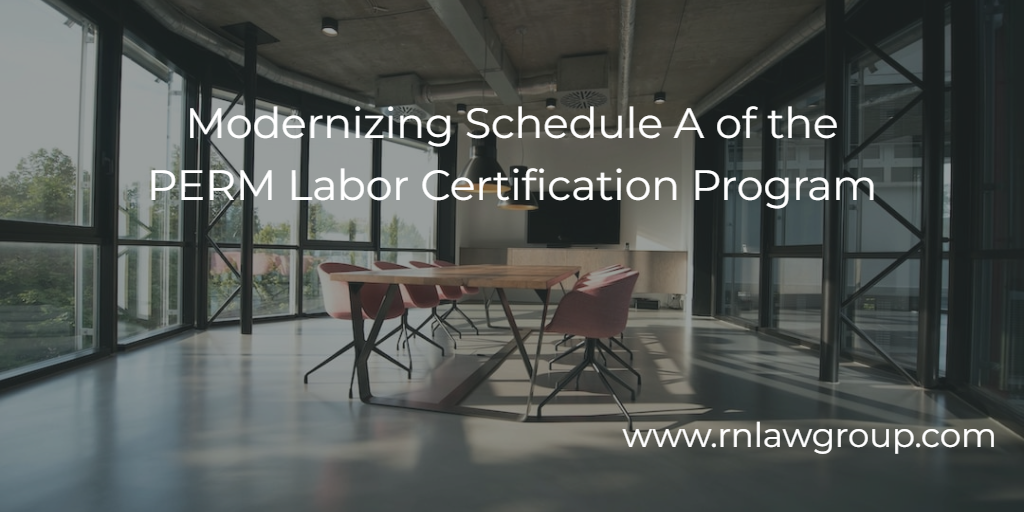
Modernizing Schedule A of the PERM Labor Certification Program
A PERM labor certification is a certification made by the U.S. Department of Labor (DOL) that: (1) there are insufficient U.S. workers in the area of intended employment who are “able, willing, qualified, and available” to perform the job; and (2) employment of the foreign worker will not adversely impact the wages and working conditions of U.S. workers in similar jobs.
PERM regulations require a sponsoring employer to test the U.S. labor market through various recruitment methods for “able, willing, qualified, and available” U.S. workers. If no such U.S. worker is found through good faith recruitment, an employer can file a PERM labor certification application on ETA Form 9089 on behalf of the beneficiary. Generally, a PERM labor certification is required if an employer is filing an EB-2 or EB-3 immigrant petition on behalf of a beneficiary.
In the mid-1960s, the DOL established Schedule A of the PERM labor certification program to address the labor demand during a period of rapid economic expansion in the U.S. Schedule A enumerates a list of occupations for which the DOL has predetermined there are insufficient U.S. workers who are “able, willing, qualified, and available.” Because of the occupational shortage of these U.S. workers, the DOL has “pre-certified” Schedule A occupations. An employer who wishes to hire a foreign worker for a Schedule A occupation is not required to test the U.S. labor market and file a PERM labor certification application with the DOL. Instead, the employer must apply for Schedule A designation by submitting an uncertified PERM labor certification application to the U.S. Citizenship and Immigration Services (USCIS) in conjunction with the Form I-140 Immigrant Petition for Alien Workers.
Currently, the following occupations are the Schedule A occupations:
- Group I – physical therapists and professional nurses; and
- Group II – immigrants of exceptional ability in the sciences or arts, including college and university teachers, and immigrants of exceptional ability in the performing arts.
The last time Schedule A was revised was in 2004. Recent research and studies suggest that the economic and labor market conditions have changed for industries and occupations that depend on foreign workers. Specifically, research and studies suggest there is a labor shortage in Science, Technology, Engineering and Mathematics (STEM) occupations, including occupations in Artificial Intelligence (AI). The DOL notes that various articles and studies attribute the labor shortage in STEM occupations to: a lack of interest in STEM occupations, a STEM branding problem with younger generations, and employers’ lack of access to foreign talent.
As a result, the DOL is considering revising Schedule A to include STEM occupations and other non-STEM occupations. The DOL announced issuance of a Request for Information (RFI), titled “Labor Certification for Permanent Employment of Foreign Workers in the United States; Modernizing Schedule A to Include Consideration of Additional Occupations in Science, Technology, Engineering and Mathematics (STEM) and Non-STEM Occupations,” on December 15, 2023. The purpose of the RFI is to invite the public to comment on the topics outlined in the RFI. The public is open to comment on the RFI through February 20, 2024.
Specifically, the DOL invites the public to provide input on:
- Whether any STEM occupations should be added to Schedule A, and why;
- Defining and determining which occupations should be considered as falling under the umbrella of STEM, and why.
The DOL also invites the public to answer the following questions:
- Besides the OEWS, ACS, and CPS, what other appropriate sources of data are available that can be used to determine or forecast potential labor shortages for STEM occupations by occupation and geographic area?
- What methods are available that can be used alone, or in conjunction with other methods, to measure presence and severity of labor shortages for STEM occupations by occupation and geographic area?
- How could the Department establish a reliable, objective, and transparent methodology for identifying STEM occupations with significant shortages of workers that should be added to Schedule A?
- Should the STEM occupations potentially added to Schedule A be limited to those OEWS occupations used in most of the recent BLS publications, or should the STEM occupations be expanded to include additional occupations that cover STW occupations?
- Beyond the parameters discussed for STW occupations, should the Department expand Schedule A to include other non-STEM occupations? If so, what should the Department consider to establish a reliable, objective, and transparent methodology for identifying non-STEM occupations with a significant shortage of workers that should be added to or removed from Schedule A?
In sum, the DOL is seeking public input on how it can develop a dependable, impartial, and transparent methodology for updating Schedule A to include STEM and other non-STEM occupations that are facing a labor shortage. This request also includes data, statistical metrics or models, studies, and other pertinent information. The DOL will use public input in its efforts to improve Schedule A so that it effectively addresses national labor shortages.
There are benefits to having Schedule A designation. A sponsoring employer is not required to conduct the recruitment process – a process which can be costly and arduous. For example, all PERM labor certification applications, whether for a professional or non-professional occupation, require the following recruitment efforts:
- 30 day job order with the State Workforce Agency serving the area of intended employment;
- Two Sunday print advertisements in a newspaper of general circulation in the area of intended employment, most appropriate to the occupation and most likely to bring responses from able, willing, qualified, and available U.S. workers; and
- Notice of Filing to be posted at the job site for a period of 10 consecutive business days. (Please note, a Notice of Filing is still required for Schedule A designation petitions.)
In addition to the mandatory recruitment mentioned above, the DOL requires 3 additional recruitment efforts to be posted if the PERM labor certification application is for a professional occupation. The employer must choose 3 of the following:
- Job Fairs
- Employer’s company website
- Job search website
- On-Campus recruiting
- Trade or professional organization
- Private employment firms
- Employee referral program
- Campus placement office
- Local or ethnic newspaper; and
- Radio or TV advertisement
With Schedule A designation, the employer can forgo the recruitment process (save for posting the Notice of Filing) and thus, is not required to bear the cost for advertising.
Another benefit of Schedule A designation is time efficiency. The sponsoring employer does not have to file the PERM labor certification application with the DOL, where adjudication is currently taking 11 to 12 months. Furthermore, if the PERM labor certification application is selected for Audit, this will add 5 more months to the process. It is important to note that unfortunately, the DOL does not provide a premium processing option for PERM labor certification applications. In turn, it is an extremely lengthy process for individuals who are not eligible for Schedule A designation.
In conclusion, the government’s efforts to modernize Schedule A of the PERM labor certification program represent a significant step towards addressing the labor shortage in Science, Technology, Engineering and Mathematics (STEM) occupations and other non-STEM occupations. The success of these modernization attempts will depend on the ability to develop a dependable, impartial, and transparent methodology for updating Schedule A to include these occupations that are facing a labor shortage.
Individuals interested in leaving comments on the RFI must submit their comments on or before February 20, 2024. Comments can be submitted electronically by following the below steps.
- Visit the Federal eRulemaking Portal at https://www.regulations.gov and follow the instructions on the website for submitting comments.
- Include the docket number ETA–2023–0006 in your comments. All comments received will be posted without change to https://www.regulations.gov.
Reddy Neumann Brown PC. is dedicated to helping our clients navigate the U.S. business immigration system. Because the U.S. business immigration system can be tricky, it is always best to contact a qualified immigration attorney to help come up with the proper solution for each individual case.
By: Camille Joson
Camille Joson is a Senior Associate Attorney in Reddy Neumann Brown PC’s PERM Labor Certification Department, where she assists clients in the beginning stages of the green card process.

